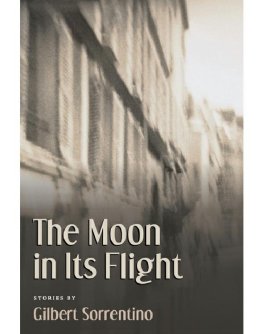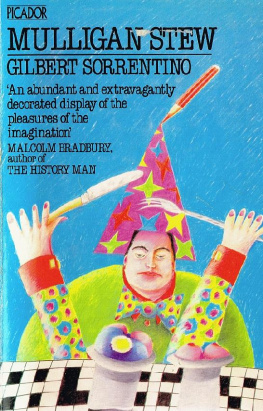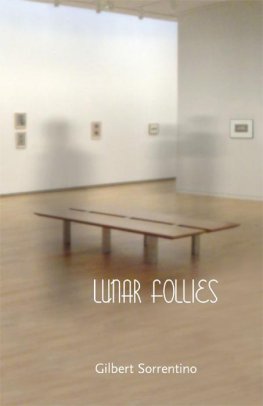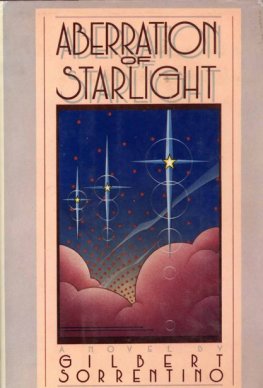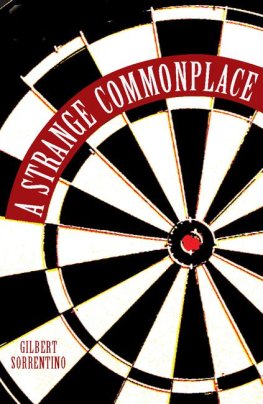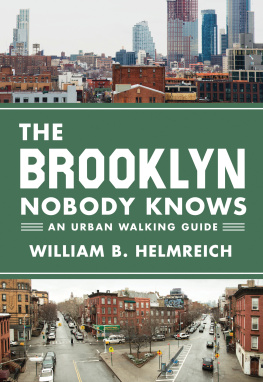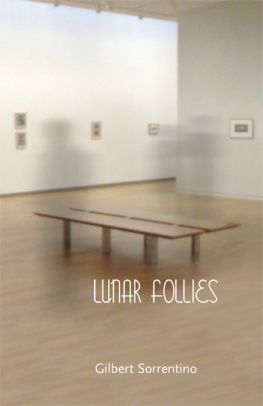THE ABYSS OF HUMAN ILLUSION
Other Books by Gilbert Sorrentino
POETRY
The Darkness Surrounds Us
Black and White
The Perfect Fiction
Corrosive Sublimate
A Dozen Oranges
Sulpiciae Elegidia: Elegiacs of Sulpicia
White Sail
The Orangery
Selected Poems 1958-1980
New and Selected Poems 1958-1998
FICTION
The Sky Changes
Steelwork Imaginative Qualities of Actual Things
Splendide-Htel
Flawless Play Restored: The Masque of Fungo
Mulligan Stew
Aberration of Starlight
Crystal Vision
Blue Pastoral
Odd Number
A Beehive Arranged on Humane Principles
Rose Theatre
Misterioso
Under the Shadow
Red the Fiend
Pack of Lies
Gold Fools
Little Casino
The Moon in Its Flight
Lunar Follies
A Strange Commonplace
ESSAYS
Something Said
BIBLIOGRAPHY
Gilbert Sorrentino: A Descriptive Bibliography by William McPheron

COPYRIGHT 2009 by the Estate of Gilbert Sorrentino
COVER AND BOOK DESIGN by Linda Strand Koutsky
AUTHOR PHOTOGRAPH Vivian Ortiz
COFFEE HOUSE PRESS books are available to the trade through our primary distributor, Consortium Book Sales & Distribution, www.cbsd.com or (800) 283-3572. For personal orders, catalogs, or other information, write to: info@coffeehousepress.org.
Coffee House Press is a nonprofit literary publishing house. Support from private foundations, corporate giving programs, government programs, and generous individuals helps make the publication of our books possible. We gratefully acknowledge their support in detail in the back of this book.
To you and our many readers around the world,
we send our thanks for your continuing support.
LIBRARY OF CONGRESS CIP INFORMATION
Sorrentino, Gilbert.
The abyss of human illusion/Gilbert Sorrentino.
p. cm.
ISBN 978-1-56689-233-9 (alk. paper)
ISBN 978-1-56689-286-5 (ebook)
1. City and town lifeNew York (State)New YorkFiction.
2. NeighborhoodNew York (State)New YorkFiction.
3. Brooklyn (New York, N.Y.)Fiction. 1. Title.
ps3569.07a74 2010
813.54dc22
2009028064
Sections of this book previously appeared in
Golden Handcuffs Review and The Brooklyn Rail.
THE ABYSS OF HUMAN ILLUSION

Contents
A NOTE TO THE READER
The Abyss of Human Illusion was begun by my father in October 2003, and a first draft was mostly complete when he was diagnosed with cancer in the fall of 2005. Both the disease and its treatment rapidly incapacitated him, and he had little physical or intellectual energy available to sit at his desk and work. Despite this, he did work throughout his final months to complete what he referred to matter-of-factly as my last book, finishing it a few weeks before his death in May 2006. At the time, he provided me with a typescript, heavily corrected and with marginal notations, consisting of the main sections of the novel, as well as a composition notebook in which hed drafted in longhand the brief glosses on these sections, which together comprise the book in its entirety.
In preparing the manuscript for publication, I encountered one immediate problem. As his strength faded, my fathers handwriting (somewhat difficult to read under the best of circumstances) deteriorated to the point of near illegibility. Determining his intentions was made more difficult by his habitually precise, but not necessarily consistent or orthodox, approach to punctuation, typography, and so forththe minutiae most commonly in question. Less frequently, although more problematically, I came across indecipherable words and phrases. Often these became clear in context, or were repeated elsewhere more legibly, and thus were easily transcribed. In some instances, though, I have taken an educated guess, drawing on my familiarity with my fathers work and verbal mannerisms. I found these to be relatively simple decisions, although doubtless there are some presumptuous flaws in my leaps of conjecture.
My father never made the switch to word processing, and habitually made handwritten revisions and alterations to his work only periodically and at discrete stages in the processthe now-common practice, familiar to writers of my generation, of intermittent, even fitful, revision and the subsequently frequent creation of wholly updated documents was unknown to him. In other words, I was working with what amounted to a corrected first draft, and in places the absence of the author from several stages of composition could be felt. While some sections called for only minor modificationsthe correction of obvious errors and unintentional inconsistencies, for exampleothers raised the issue of their suitability for inclusion. In the end, I decided to ready the manuscript in its entirety for publication, for reasons that readers, and certainly writers, may find interesting.
For much of his career, my father delighted in writing within formal constraints (a practice that gave rise to what may be his defining remark, Form not only determines content, but form invents content.). Some of the forms he devised allowed tremendous opportunity for play, in other cases the approach demanded a rigorous observance of prescribed rules and procedures. Correspondingly, while sometimes the formal conceits in his novels are obvious or easily grasped (the algorithmic mechanism of Aberration of Starlight; the use of the Tarot deck in Crystal Vision), many of his later books offer a less apparent and/or more indeterminate structure, and it is among this latter group that The Abyss of Human Illusion belongs. Though one aspect of its structure is evident even from a cursory look at the book (Its fifty sections grow incrementally longer; while the first is around 130 words, the last is around 1,300), its other formal ambitions remain unclear (to me).
Add to this the fact that, as is often the case with my fathers work, there is a dense measure of intertextuality present in the booksections of the book refer, or seem to refer, to one another, to my fathers other books, to episodes depicted in those other books, and to stories and poems by others (Section XVI, for instance, is a loose reinterpretation of Rimbauds early poem, Winter Dream.). Perhaps not-so-paradoxically, the technical goals my father set only rarely trumped his beliefhis faith, evenin serendipity, accident, in the aesthetically justified deviation from constraint that the OuLiPo named the clinamen; in standing back and seeing for himself whether a thing was finished to his satisfaction. Ultimately, the correct artistic balance was something my father determined not by having fully executed a schematic requirement, but, for better or worse, in the scale of his hand.
Accordingly, while I have made surgical excisions and interpolative changes as described above, and while I have, on occasion, cut sentences, phrases, and even paragraphs where it seemed to me that my father abruptly galloped off on one of the well-lathered hobbyhorses he rode over the years, or bore down on something more heavily than I believed his finely calibrated sense of irony and sarcasm would have allowed to stand, I have gone no further in editing this book. The scale of my own hand, though competent and discerning, is not that of his, and that alone is enough to stop me. Perhaps in time, when Sorrentino scholarship is not the exclusive pursuit of devoted sons and other deviants, a definitive edition of


